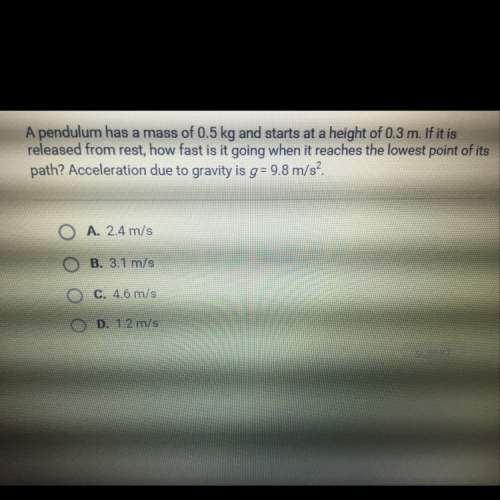
Which of the following statements are true about the electric potential or the electric potential difference? (a) the si unit of the electric potential is volts (v). (b) the electric potential can also be expressed in units of joules. (c) the electric potential produced by a charge at a given location provides a measure of the rate at which charge flows past that point. (d) as a positive charge moves in the direction of an electric field, it gains electric potential. (f) the electric potential difference between two points is the difference in potential energy possessed by another charge at those two points, divided by this charge.

Answers: 3
Other questions on the subject: Physics

Physics, 21.06.2019 19:00, shanicet047ox9ff6
Find the momentum for a 2.6-kg brick parachuting straight downward at a constant speed of 8.4 m/s .
Answers: 3

Physics, 21.06.2019 22:30, mirellaenriquez5529
Follow these directions and answer the questions. 1. shine a pencil-thin beam of light on a mirror perpendicular to its surface. (if you don't have a laser light as suggested in the video, you can make a narrow beam from a flashlight by making a cone from black construction paper and taping it over the face of the flashlight.) how does the light reflect? how does the relationship of incident to reflected ray relate to the reflection of water waves moving perpendicular to a barrier? 2. shine a pencil-thin beam of light on a mirror standing on a sheet of paper on the table (or floor) so that you can mark the incident ray and reflected ray. (you can support the mirror from the back by taping it to a wooden block.) 3. mark a line on the paper representing the reflective surface. (the reflective surface of a mirror is usually the back edge.) 4. draw a dashed line perpendicular to the mirror surface at a point where the incident and reflected ray meet. this perpendicular is called a normal to the surface. 5. measure the angles between the rays and the normal. the angle of incidence is the angle formed by the incident ray and the normal to the surface. the angle formed by the reflected ray and normal is called the angle of reflection (r). what is the angle of incidence? what is the angle of reflection? 6. repeat for several different angles. (see report sheet for details.) what appears to be the relationship between the angle of incidence and angle of reflection? in science 1204, what was the relationship for these two angles made by the reflection of waves in a ripple tank? 7. roll a ball bearing so that it hits a fixed, hard surface (a metal plate) at several angles (including head-on). observe the way in which the ball bearing reflects. what generalization can you make about how a ball bearing reflects from a wall? have you proved that light can only behave like a wave?
Answers: 1

Physics, 22.06.2019 02:10, allytrujillo20oy0dib
How is coal extracted from mountaintop removal mines? a. dynamite is used to create underground tunnels where miners go to extract the coal. b. dynamite is used to break apart rocks and then draglines are used to remove the broken rock and reach the coal. c. coal in mountaintops is extracted by digging strips in the landscape to reach the coal. d. placer deposits in mountain river bottoms are removed by
Answers: 2

Physics, 22.06.2019 03:30, hannahbaak
Will give brainliest! jay rides his 2.0-kg skateboard. he is moving at speed 5.8 m/s when he pushes off the board and continues to move forward in the air at 5.4 m/s. the board now goes forward at 13 m/s. a. determine jay’s mass. b. determine the change in the internal energy of the system during this process.(express your answer to two significant figures and include the appropriate units.)
Answers: 1
Do you know the correct answer?
Which of the following statements are true about the electric potential or the electric potential di...
Questions in other subjects:


Mathematics, 17.12.2021 01:40

Mathematics, 17.12.2021 01:40






Mathematics, 17.12.2021 01:40








